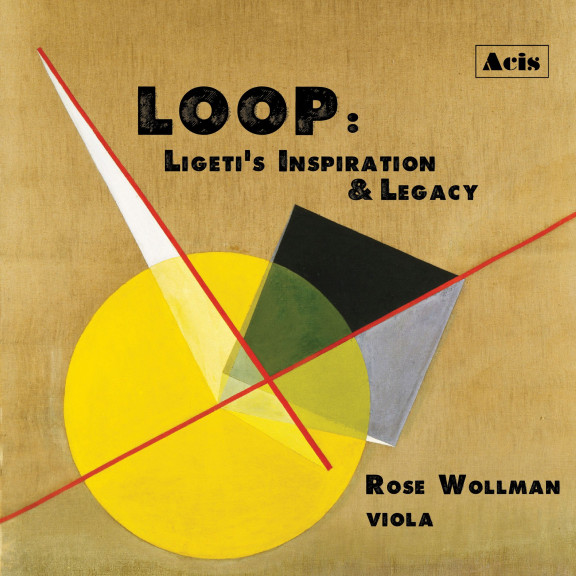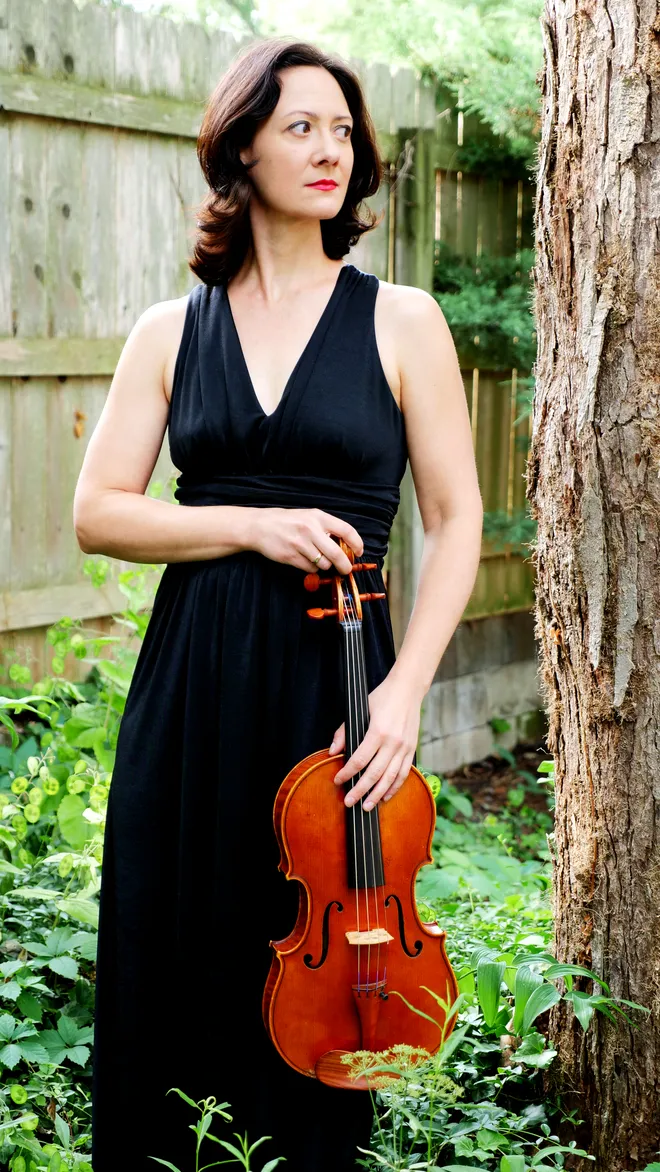Rose Wollman – Loop: Ligeti’s Inspiration & Legacy

Violist Rose Wollman's Loop: Ligeti's Inspiration & Legacy (2022)
In celebration of what would have been György Ligeti’s 100th birthday on May 28, we caught up with violist Rose Wollman to discuss her latest album for Acis Productions, Loop: Ligeti's Inspiration and Legacy. Local audiences may already be familiar with Wollman’s work. Last February, she came to the University of Illinois campus to perform the program on this album, which sheds new light on Ligeti's monumental Sonata for Viola Solo. She is also an alumna of the University of Illinois, having earned her Bachelor of Music there in 2004. Read on to learn more about the composer and hear from the artist herself about how this project came to be.
Hungarian composer György Ligeti (1923–2006) was born in what is now Transylvania, Romania. His musical studies were interrupted in 1944 when he was sent to a Nazi forced labor camp. His younger brother was killed at the Mauthausen concentration camp, and his parents were taken to Auschwitz, where his father was also killed. György was lucky to survive, escaping the Nazis while transporting heavy munitions to the front line. In 1956, Ligeti made yet another harrowing escape. He and his wife, Vera, fled the Hungarian People’s Republic during the Hungarian Uprising by hiding under mail bags on a train and walking under cover of darkness through the mud of no-man’s land to Austria.
The move West allowed Ligeti greater creative freedom, and his compositional style changed radically. He reinvented himself as an avant-garde composer and developed new compositional techniques, focusing on texture as a driving musical force as much as pitch and rhythm. He is now regarded as one of the most important composers of the second half of the twentieth century and is one of the few post-war avant-garde composers to receive frequent performances to this day. Director Stanley Kubrick is credited with bringing Ligeti’s music into the popular consciousness, famously using his music in 2001: A Space Odyssey and The Shining to evoke the supernatural, inhuman, or psychologically disturbed.
Rose Wollman has taken an ingenious approach to one of Ligeti’s late works, the Sonata for Solo Viola, written between 1991 and 1994. Her 2022 album for Acis Productions, Loop: Ligeti’s Inspiration & Legacy, expands upon Ligeti’s six-movement sonata. Wollman pairs each movement of the sonata with a baroque piece and a contemporary commission, creating six “triptychs.” The baroque and contemporary companion pieces “complement and highlight the influences present in Ligeti’s sonata,” Wollman writes in her program notes, “[placing] Ligeti’s monumental sonata as a bridge between the past and the future.” Though the title of the album, Loop, refers to the second movement of the sonata, she says, “it is also a reference to the interconnected influences of artistic creation.”
Ligeti places some uniquely challenging technical demands on the violist. Microtonal inflections and chromaticism can be heard throughout, and high positions on the C string and double stops with open strings require athleticism in the left hand. Despite its modern technical demands, Ligeti’s sonata is an homage to music of the past, being loosely organized as a baroque suite. The first movement, Hora lungă, is like a fantasy—“a meditation in a key, like the prelude of a dance suite,” Wollman writes. The second movement, Loop, echoes a gigue in its dance-like rhythms, while the third movement, Facsar, mirrors the structure of a baroque passacaglia with its repeated melody. Prestissimo con sordino has the frenetic pace of a moto perpetuo, while Lamento is related to a moderately paced French baroque dance called a loure. Finally, the wild Chaconne chromatique has “twelve minutes’ worth of music packed into three!”
Preceding each movement of the Ligeti with a baroque selection further illuminates the baroque influences in Ligeti’s music that may otherwise go unnoticed, giving the starkly modern music some historical grounding. The contemporary commissions also reflect the lineage of baroque music in their own ways. Wollman wrote one of the contemporary companion pieces herself, Wanderlust, which comes after Facsar. Like Facsar, Wanderlust is also a riff on a baroque passacaglia, adding unexpected twists to the bassline of Pachelbel’s famous Canon in D.
To get some more insight into Loop: Ligeti's Inspiration & Legacy, we asked Wollman a few questions about the project’s genesis and impact over email.
KB: Where did the inspiration come from for Loop: Ligeti's Inspiration & Legacy, and how did it develop?
RW: This project is really a product of the pandemic. In the summer of 2020, like every other musician I know, I had a completely decimated concert schedule and no one to play music with! I had learned the first three movements of the Ligeti Sonata for Viola Solo during my doctorate, but did not learn the other three, and this seemed like the perfect project for a summer without other musical outlets.
As I worked on it, a couple things really struck me. One was that I needed to think very carefully about how to program this sonata so I could help audiences love it as much as I do. It’s six movements, about 22 minutes, harmonically dense, instrumentally difficult, (and, ya know, for solo viola...) and a pretty big ask of audiences who are used to Bach and Brahms. The other thing was how much baroque influence there is in Ligeti's writing. I had studied Ligeti’s music in the past, so intellectually I knew this about him, but working on this sonata made it very visceral for me.
When I first had the idea to interweave baroque movements with the sonata, I tried it with a Bach Cello Suite (no. 1, I think). I really liked the palate-cleansing aspect of the Bach movements between each movement of Ligeti; I also liked how it affected the way I played Ligeti. His gestures made more sense, everything was a bit lighter, and the shapes and voices came into focus for me. At this point I began thinking about recording an album. I didn’t want to use a whole Bach suite, partly because it was not as specifically matched to Ligeti as I wanted, and partly because they have been recorded a million times by amazing artists and I didn’t think I had much to add to that particular body of work. I started looking for baroque movements I could arrange or transcribe for solo viola that would really match the affect of each Ligeti movement. Some came very easily (Bach’s Suite No. 5 – Prelude with Hora lungă, Biber’s Passacaglia with Chaconne chromatique); and some took much more digging around (Tartini’s Furlana with Loop, and Telemann’s Fantasie No. 12 with Lamento). None of the baroque pieces were originally for viola (composers didn’t figure out that viola is the best instrument until much later), so I stole them all from the violin and cello repertoire.
One of the really amazing things about Ligeti is that he draws so much from the past and is also monumentally influential to composers today. I decided to commission companion pieces for each baroque–Ligeti pair, both to honor this aspect of Ligeti’s legacy and also because working with composers is one of my very favorite things! Five of the composers I asked are (or were) violists, one is a cellist, and I had an existing personal relationship with many of them. The commission instructions were a bit unusual because I asked the composers to write a piece to be performed in a specific context, as a “third movement” to a short suite. Some of them really took this to heart and wrote something very integrated, and some took the spirit and elements of the inspiration movements and wrote a piece that could easily stand on its own. It was so interesting to see what they each came up with, and seeing their personalities in their music and also the way they approached the task. I could not be happier with these pieces; they add so much depth and life to the program!
I recorded the Ligeti and baroque pieces in January 2022, the commissions in May, and the album was released in October. This is the biggest single project I have done so far. The program is extremely technically and musically demanding, and it took me almost two years to get it all recorded. It really kept me sane during the pandemic, though. I had a goal to focus on what I could do without sharing oxygen with people outside my bubble. I did much of my practicing in our laundry room while my daughter slept so I wouldn’t wake her up, and my husband and I joke that this album is her sibling! I also think of this as my post-doc; I learned so much and am a better violist and musician now than I was before.
KB: How do you think pairing each Ligeti movement with a baroque and contemporary piece sheds new light on Ligeti's sonata? Would you say that doing so opens up the work to listeners who wouldn't necessarily gravitate to Ligeti or other avant-garde composers?

Violist Rose Wollman
Photo credit: Daniel Stein
RW: I do think the pairings shed new light on Ligeti’s sonata. My goal with this program was to help an audience understand and appreciate Ligeti’s sonata on a first listen. I know that some people like to familiarize themselves with the music before going to a concert, but my guess is that they are the exception not the rule. I wanted to create a program that would help a traditional classical music audience digest this music, specifically with regard to his baroque influences. (There are plenty of other avenues I could have gone down for this project: there is Hungarian folk music in his writing and plenty of other modern influences.) I think that any given performance of any piece is going to say different things to different people, but this program directs the audience’s ears a certain way that highlights specific aspects of the sonata and possibly downplays others. One performance or recording cannot be everything to everyone, and this program is very focused on a specific element of Ligeti’s style.
I think this program intrigues audiences that are not usually drawn to avant-garde composers, and that was certainly one of my goals. Many of the baroque pieces I chose are not often performed (by modern players, at least), so I think that is exciting to audiences. The commissions are also all “easier” listening than Ligeti’s sonata, partly because the baroque piece was part of the inspiration and partly because that is the musical language of the composers I chose. So Ligeti’s sonata is sandwiched between pieces that are much more readily accessible, and also specifically tailored to Ligeti’s movements. As humans, we enjoy what is familiar, and under the veneer of the avant-garde craziness there is plenty that is familiar in Ligeti’s music!
You can stream Loop: Ligeti's Inspiration & Legacy on Spotify or Apple Music, or purchase the album here.



